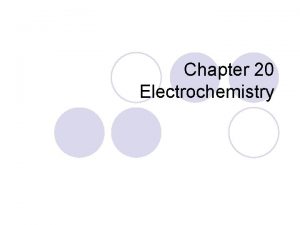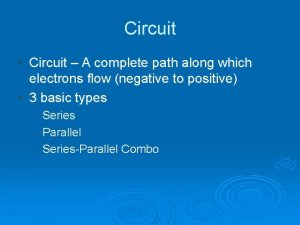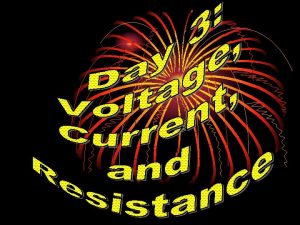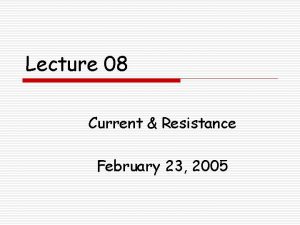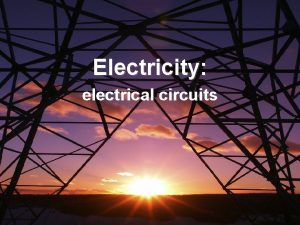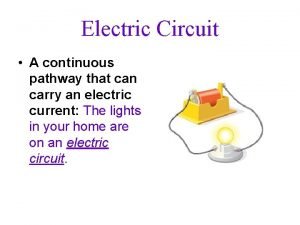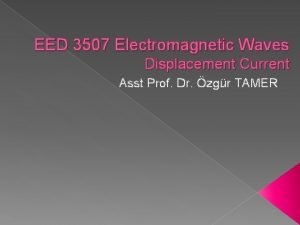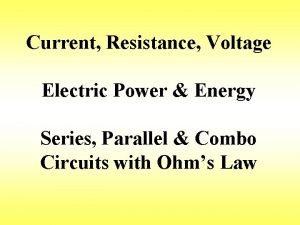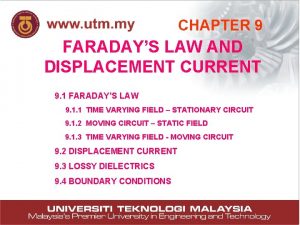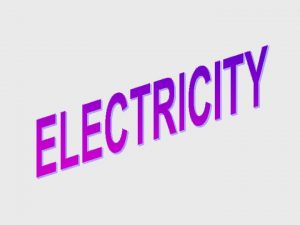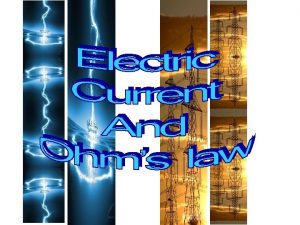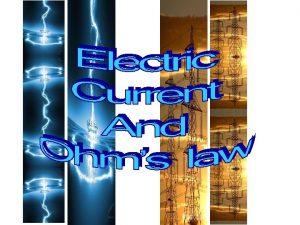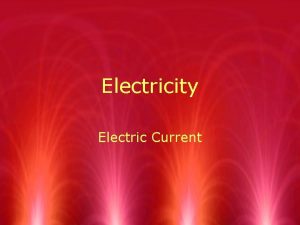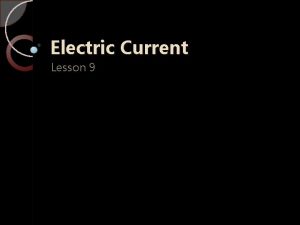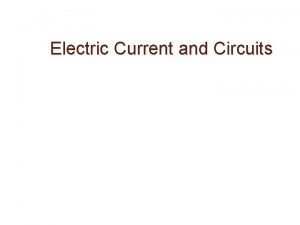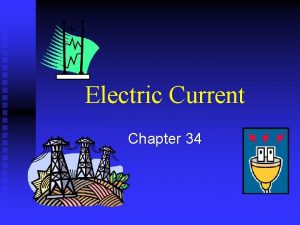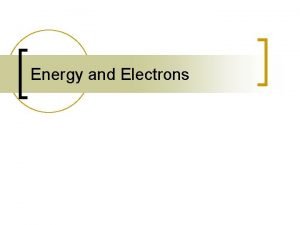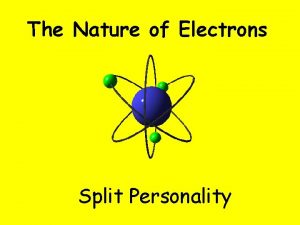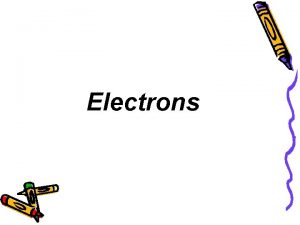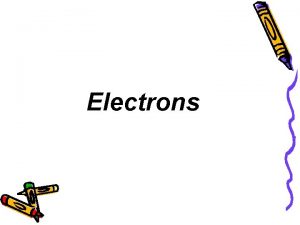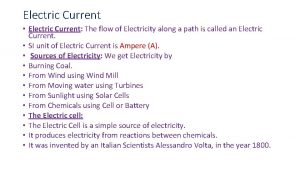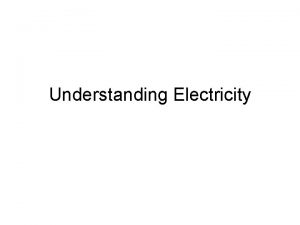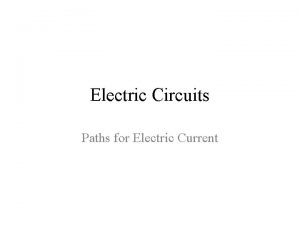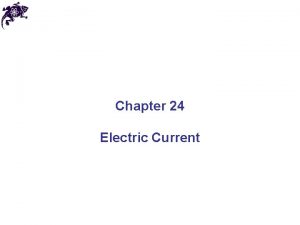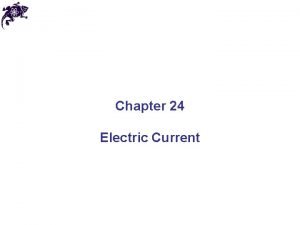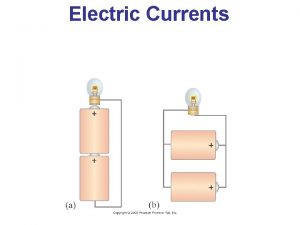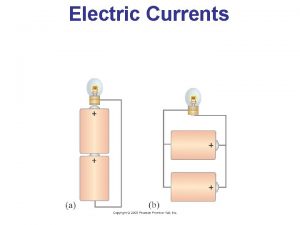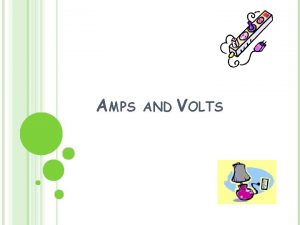Electric Current Electric Current Flow of electrons at




























- Slides: 28

Electric Current

Electric Current • Flow of electrons at a given point The higher the current, the more electrons pass through a point

Electric Current • Measured in units called amperes (A)

There are two kinds of electric currents: Direct Current Alternating Current

Direct Current (DC) • Electrons flow only one direction

DC Example: • Current from batteries

Alternating Current (AC) • Electrons flow both directions Change directions 100 times a sec (one step forward, one step back)

AC Example: • Current from outlets

Top of hill… bottom of hill • Difference in height between two points allows you to roll down the hill Same thing happens with currents – the “hill” that allows movement is voltage

Voltage • Potential difference between two points in a circuit Measured in units called volts (V)

Voltage • Measure of how much work is needed to move electrons between two points Think of it as… • Amount of energy released as electrons move between two points • The higher the voltage, the more energy is released per electron

The size of the current depends on the voltage • The greater the voltage, the greater the current is Greater current means that more electrons are flowing in the wire per second

Large current is needed to start a car so a car battery has fairly high voltage 12 V 6 V 9 V 1. 5 V

Resistance is another thing that determines the amount of current in a wire

Resistance • Opposition to the flow of electrons by a material or device • Measured in ohms (Ω)

Resistance depends on… • Material • Thickness • Length • Temperature Similar to water flowing through a pipe

Materials • Good conductors have low resistance while poor conductors have higher resistance Copper Iron High resistance of light bulb filament allows it to heat up and give off light

Thickness • Thick wire has less resistance because there is more area for the current to go through

Length • Short wire has less resistance because there is less distance to work through

Temperature • Resistance of metals increases as temperature rises Atoms vibrate faster and get in the way of flowing electrons

Ohm’s Law • Current equals voltage difference divided by the resistance I (A) = V (V) R (Ω) If I increase resistance, what happens to the current? If I increase voltage difference, what happens to the current?

Question • What is the voltage difference across a 25 Ω resistor if a 0. 3 current is flowing through it? I (A) = V (V) R (Ω) • What happens to the voltage difference if the current is doubled?

Review 1. Resistance is measured in unit called… a. joules b. watts c. volts d. amps e. ohms

Review 2. Resistance to electron flow will be greatest in… a. Thick wire or Thin wire b. Long wire or Short wire c. Copper wire or Plastic wire d. Copper wire or Silver wire

Review 3. The rate at which electrons flow through a circuit is ______ to the resistance. a. Inversely related b. Directly related c. Not related

Review 4. Which is the ohms equation? a. I = R/V b. R = I/V c. I = V/R d. V = I/R

Review 5. Given that all other factors are equal, the current will be greatest in a circuit that has… a. b. c. d. e. high resistance or a low resistance Long wires or short wires Wide wires or thin wires 12 gauge wires (1/12 inch) or 14 gauge wires (1/14 Copper wiring or silver wiring th th inch)

Review 6. Which of the two circuits (A or B) has the greatest resistance? Calculate the value
 Electrons flow from anode to cathode
Electrons flow from anode to cathode Cell representation
Cell representation Chapter 20 electrochemistry
Chapter 20 electrochemistry A path along which electrons can flow
A path along which electrons can flow Y connected generator
Y connected generator Phase to phase voltage
Phase to phase voltage Semiconductor
Semiconductor Ac theory 3 lesson 4
Ac theory 3 lesson 4 Drift vs diffusion current
Drift vs diffusion current Intrinsic semiconductor
Intrinsic semiconductor Gm formula for mosfet
Gm formula for mosfet In a triangle connected source feeding a y connected load
In a triangle connected source feeding a y connected load Infineon
Infineon Diffusion current formula
Diffusion current formula Why must the electrode holder be correctly sized?
Why must the electrode holder be correctly sized? Touch current vs leakage current
Touch current vs leakage current Non planar circuit
Non planar circuit Voltage difference def
Voltage difference def Electric current formula
Electric current formula Nature of electric current
Nature of electric current Chapter 23 electric current circuit happenings
Chapter 23 electric current circuit happenings Continuity equation for time varying field
Continuity equation for time varying field Rope loop model electricity
Rope loop model electricity Electric current
Electric current Pathway for carrying an electrical current.
Pathway for carrying an electrical current. Maximum displacement current
Maximum displacement current How to find voltage in a parallel circuit
How to find voltage in a parallel circuit Electric current in water
Electric current in water Current9
Current9


